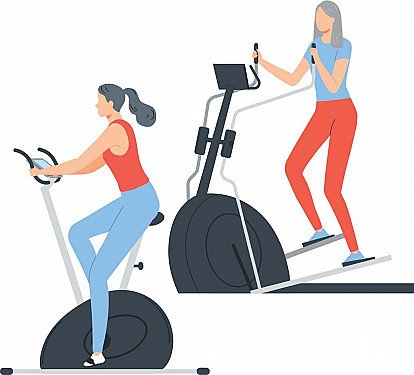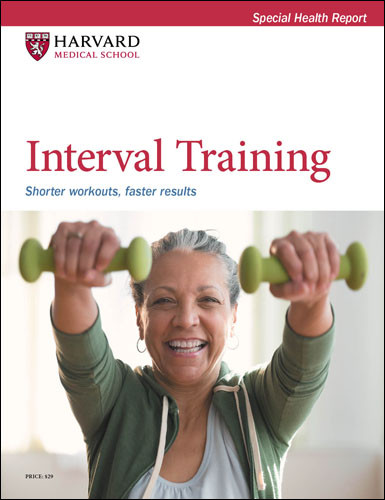Interval training: A shorter, more enjoyable workout?
Adding bursts of high-intensity exercise to your fitness regimen may benefit your mind as well as your heart.
- Reviewed by Christopher P. Cannon, MD, Editor in Chief, Harvard Heart Letter; Editorial Advisory Board Member, Harvard Health Publishing

As one of the most popular exercise trends for more than a decade, high-intensity interval training (HIIT) clearly provides some perks. These workouts aren't just a time-efficient way to boost your fitness. Research shows that HIIT can improve key measures of cardiovascular health for all sorts of people, including those recovering from heart attacks or heart surgery. Another advantage: high-intensity effort, even for just brief bursts, may trigger the release of mood-boosting brain chemicals.
As its name implies, HIIT features high-intensity (vigorous) activity done in intervals (short time periods) with brief periods of either rest or lower-intensity activity in between. During the bursts of vigorous exercise, your heart rate rises higher, and then it remains higher than it would normally be in between those high-intensity bouts. Compared to 20 minutes of moderate-intensity exercise, a 20-minute HIIT session will burn more calories, strengthen your heart more, and help your body use oxygen more efficiently.
"If your goal is to improve your fitness, doing moderate-intensity exercise certainly works. But HIIT workouts may raise your fitness level faster in a shorter period of time," says Dr. Sawalla Guseh, director of the Cardiovascular Performance Program at Harvard-affiliated Massachusetts General Hospital. As he points out, if you do mostly vigorous exercise, you can meet the federal exercise guidelines in just 75 minutes per week, where-as doing mostly moderate exercise takes twice as long (150 minutes per week).
Happier with HIIT?
If long sessions of vigorous exercise feel too challenging, adding some HIIT workouts to your exercise regimen can be a happy medium. Even short stints of high-intensity exercise appear to trigger the release of endorphins — the brain's "feel good" chemicals. "In our clinic, we certainly see patients who say that HIIT workouts bring them the most joy," Dr. Guseh says. In addition, endorphins can counteract pain, which may mitigate some of the discomfort that can occur during HIIT workouts, so people perceive them as more pleasant than expected.
Still, the most important thing is to find a form of exercise that you enjoy and can do consistently over the long haul, Dr. Guseh says. Steady, moderate-intensity exercise is also a great way to keep your cardiovascular system healthy.
Getting started with HIIT
If you have heart disease or are at increased risk for it, be sure to check with your doctor before adding high-intensity effort to your routine. People at increased risk include those with two or more of the following: diabetes, high blood pressure, high cholesterol, or a family history of heart disease.
Reaching the right intensity
Traditionally, HIIT features 30 to 90 seconds of high-intensity effort followed by an equal or longer period of lower-intensity activity or rest. High-intensity is often defined as reaching 85% of your maximum heart rate (see "All about your heart rate" in the June 2023 Heart Letter). A simpler option is to aim for an "8" on your personal perceived exertion scale (where 1 is very easy and 10 is as hard as you can possibly go).
When you're first starting out, alternate a few short intervals of high-intensity exercise with longer periods of moderate or easy exercise. Say you usually walk for 30 minutes at a stretch. Start by walking for five minutes. Then walk as fast as you can, or jog, for one minute. Go back to your usual pace, or even a bit slower, for three minutes. Repeat the fast walking–slower walking cycle five more times. Once you become more fit (or if you are in fairly good shape), you can spend more time walking faster or jogging and less time ambling or resting.
You can turn any cardio workout — cycling, swimming, elliptical, stationary bike, treadmill, stair climber, rowing machine, and even dancing — into an interval session. The easiest way is to simply speed up and slow down. Outdoors, add hills to a running or cycling route to create greater intensity. Indoors, you might add some stair climbing or jumping. For variety, try other HIIT variations (see "Internationally inspired interval training"). Harvard Health Publishing's report Interval Trainingfeatures five sample workouts, including warmups and stretches.
Internationally inspired interval trainingTry one of these HIIT variations to add fun and challenge to your workout. Fartlek. Swedish for "speed play," fartlek is a more relaxed, fun way of doing intervals. You don't have to worry about distance, time, or heart rate. Instead, you push yourself as long as you can based on how you're feeling or until you reach a target like a tree, light pole, house, or someone ahead of you. Then you recover for as long you need. Your intervals don't have to be identical. When you feel ready, pick another target and go. While the intervals are informal, they can still be challenging. Tabata. Named after the Japanese researcher who created it, Tabata workouts feature 20-second work intervals and 10-second recovery intervals that are done eight times in a four-minute series. Try it with any type of aerobic exercise, like walking, running, or cycling. Tabata classes often include multiple rounds of different exercises, such as jumping jacks, knee pulls, or mountain climbers, designed to work all the major muscle groups. Instructors combine different variations of the four-minute series to create workouts that last a half-hour to an hour. |
Image: © Creative Credit/Getty Images
About the Author

Julie Corliss, Executive Editor, Harvard Heart Letter
About the Reviewer

Christopher P. Cannon, MD, Editor in Chief, Harvard Heart Letter; Editorial Advisory Board Member, Harvard Health Publishing
Disclaimer:
As a service to our readers, Harvard Health Publishing provides access to our library of archived content. Please note the date of last review or update on all articles.
No content on this site, regardless of date, should ever be used as a substitute for direct medical advice from your doctor or other qualified clinician.
















